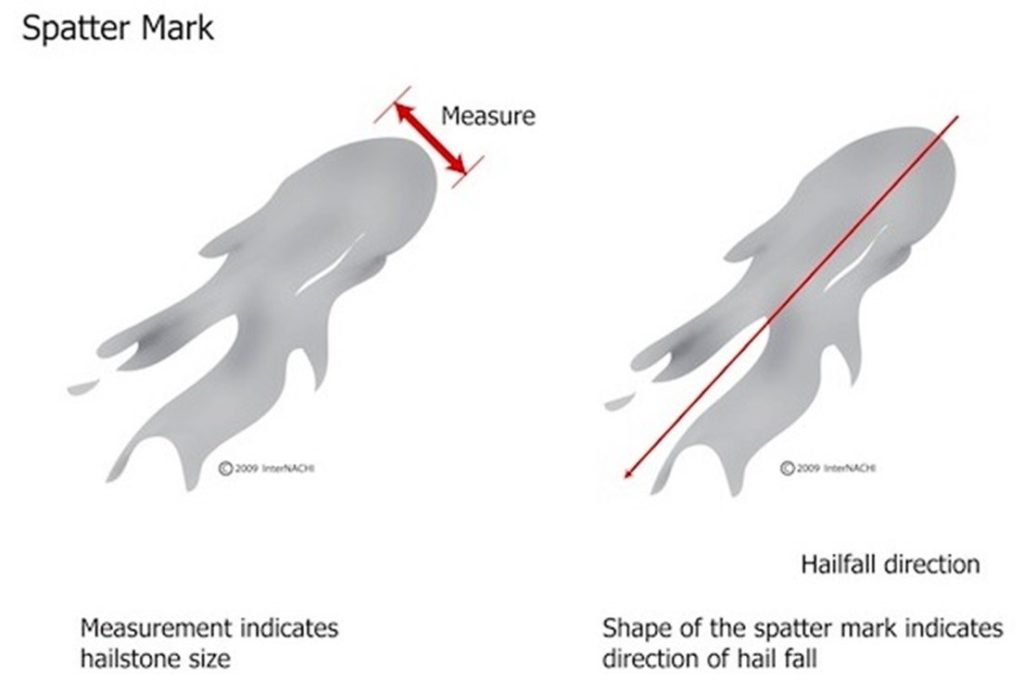All About Hail Spatter

So what is hail spatter, and why is it important?
Did you know that a quick, preliminary inspection can provide great insight into a reported hail loss and better guide you during your detailed inspection?
A preliminary inspection can provide information such as directionality and size of the hail stones, potential debris patterns, and even whether or not hail was recently present at the risk location. A lot of this information can be determined by looking at hail spatter.
 What is hail spatter?
What is hail spatter?
Typically, painted components and exposed materials form a layer of oxidation, dirt, grime, or algae over time. Hail spatter is the temporary markings left by hailstone impact, which may or may not cause damage depending on how dense the hailstone is.
Why is it important?
Hail spatter removes the layer of dirt and grime, leaving behind a mark that can tell us how large and dense the hailstones were, what direction they came from, and how recently the hailstorm occurred.
Size of the hailstone
This diagram by InterNACHI shows how to measure spatter to determine the approximate size of the hailstone. These measurements are approximate because the spatter mark can vary based on the density of the hailstone. A softer hailstone will scatter more upon impact, leaving a misleadingly larger impact area.
A lot of research has been performed by engineers and roofing manufacturers to determine how large the hailstone must be to cause damage to different types of roofing materials. In the chart below by HAAG, you can see how large the hailstone needs to be to cause damage to the roofing material.
| Roofing | Threshold |
| Lightweight asphalt shingles | 1” |
| Heavyweight asphalt shingles and wood shingles | 1¼” |
| Medium wood shingles and clay tiles | 1½” |
| Concrete tiles | 1¾” |
| Built-up roofing (smooth) | 2” |
| Modified bitumen membranes | 1½” to 2” |
| EPDM membranes (smooth) | 2” |
| Other plastic singles-ply membranes (smooth) | 1” to 2” |
| Membranes ballasted with gravel | 2½” |
| Galvanized steel panels | 2½” |
Hailstone density
If you observe spatter on soft metals without denting or damage, the hailstone was not well formed and broke apart easily on impact. There would likely be little to no actual damage from this type of hail.
Time of hailstorm
Because hail spatter is temporary in nature, it can help you determine if the observed damage was caused by a recent event or possibly an older one. The main impact point of the hailstone will leave a clean, debris-free marking and typically takes a year or two to fade away. If spatter is missing and impact points have debris, dirt, or grime built back up in the dent, the damage is most likely from an older event.
Five areas to focus on during your preliminary inspection.
Before you climb on a roof to look for damage, perform a preliminary inspection and look for the following:
- Hail spatter on trash cans, electrical panels, siding, painted items, or fencing. Spatter on these areas can quickly tell you the approximate size of the hailstone and direction of the storm.
- Denting or other damage to soft metals (fascia wrap, gutters and downspouts, aluminum siding, garage doors, etc.). These areas are more delicate than roofing and can be damaged by smaller hail impacts.Remember that hail falls at random, so if you begin to see patterns in soft metals like a straight line of dents in a gutter, it could be mechanical damage.Pro tip: Run your chalk sideways over dents to highlight the impact for your photo documentation.
- Check the HVAC unit for exposed condenser fins, which are highly susceptible to impact damage, and look for spatter on the covers of the HVAC unit.These condenser fins are made of very soft metal and can easily exhibit signs of mechanical damage, so be thoughtful in your evaluation based on the location of the unit and the location and appearance of the impact.Pro tip: Take a photo of the ID badge on the HVAC units. The model number can sometimes be used to determine the tonnage of the unit, which is important for your estimation.
- Look at the areas around the downspouts – do you see granules? Granular loss is part of general wear to the shingle but can also be caused by hail damage and be used as supporting evidence during your preliminary inspection.
- Check the horizontally exposed surfaces such as windowsills, trim pop-outs, and light fixtures. Wood or aluminum-wrapped windowsills often show spatter or impact damage from hail, depending on the direction of the storm and the location of the window.
It may seem unnecessary, but a preliminary inspection for hail spatter can save you a lot of time on-site. Homes on opposite sides of a neighborhood can experience different levels of hail damage (some can experience no damage at all!) and hail size can vary greatly in the same area so you can only rely on evidence at the location of the risk. So the next time you’re inspecting a hail loss, take five minutes to perform a preliminary inspection!
This article was written by Troy Stewart, President and Chief Operating Officer of Brush Country Claims.
Click here to view more of Troy’s content on LinkedIn

About Brush Country Claims
Brush Country Claims is an independent adjusting firm that offers a full claims solution for residential, commercial, daily, and catastrophe claim management. Brush Country utilizes an innovative suite of proprietary technology to maximize customer experience while consistently having some of the fastest cycle times in the industry. A human led, tech forward approach embraces the grassroots beginnings of the company as well as their incredible drive to propel into the future.
Related Posts
July 28, 2021
PRESS RELEASE: Lloyd’s Lab Pitch Day
GEORGETOWN, Texas – July 28, 2021 – Brush Country Claims, a Central Texas-based…
July 12, 2021
Get to Know our CAT Team Leaders
With hurricane season upon us, we wanted to do a little Q&A with our CAT team…
June 28, 2021
Rising Building Costs and Insurance Premiums
In the first half of 2021 we have seen a rapid increase in the price of…



